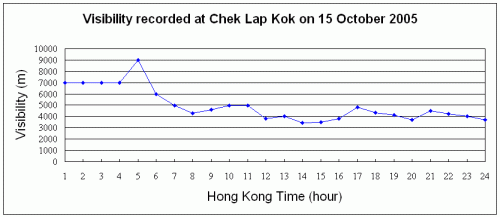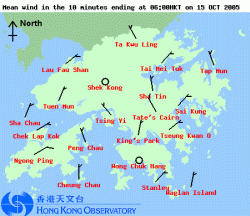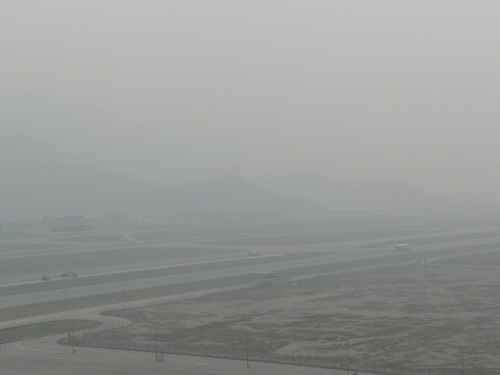Haze as a result of Northeast Monsoon
Haze as a result of Northeast Monsoon
HUNG Fan-yiu
In recent year, the number of haze hours has increased in Hong Kong and there is a growing public concern for the reduced visibility. So, what actually is haze? How is haze formed?

Without haze, the visibility is very high.

Occurrence of haze caused the reduction of visibility.
According to definition by the World Meteorological Organization, haze occurs when the visibility is reduced to below 5,000 metres by suspended particulates in an atmosphere with a relative humidity of 80% or below. Environmental Protection Department's "Study of Air Quality in the Pearl River Delta Region" in 2002 showed that the accumulation of suspended particulates is related to the air pollution. In addition to suspended particulates, fine dust in the natural environment can also be brought in by the northeast monsoon.
The following is a case of haze on 15 October 2005. A weak northeast monsoon reached the South China Coastal areas in the morning. Under the influence of light northerly winds, haze was reported with the visibility at Chek Lap Kok falling below 4,000 metres.


The 10-minute mean wind at Chek Lap Kok Airport on that day.

At 4am, winds was light easterly at Chek Lap Kok.

At 6am, winds became light northeasterly at Chek Lap Kok. The visibility started to fall.

At 8am, winds strengthened slightly and was northeasterly at Chek Lap Kok. The visibility fell below 5km.

At noon, winds was northerly at Chek Lap Kok. The visibility deteriorated to below 4km.


(Enlarged view of AOD around Hong Kong)
The images of Moderate Resolution Imaging Spectroradiometer (MODIS), a sensor of the Earth Observing System (EOS) operated by the U.S. National Aeronautics and Space Administration (NASA), revealed the aerosol optical depth (AOD) was high.
The images of Moderate Resolution Imaging Spectroradiometer (MODIS), a sensor of the Earth Observing System (EOS) operated by the U.S. National Aeronautics and Space Administration (NASA), revealed the aerosol optical depth (AOD) was high.

The visibility at Chek Lap Kok Airport was rather low on 15 October 2005, with hills barely visible in the distance.
If you would like to know more about the relationship between haze and visibility, please refer to "Analysis of Reduced Visibility due to Haze in Hong Kong", Y.S. Li and C.H. Yung, Hong Kong Observatory, 2005 (in Chinese only).